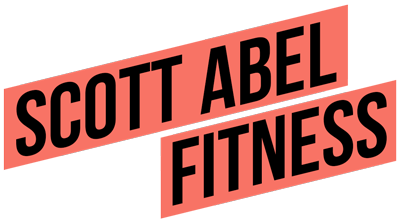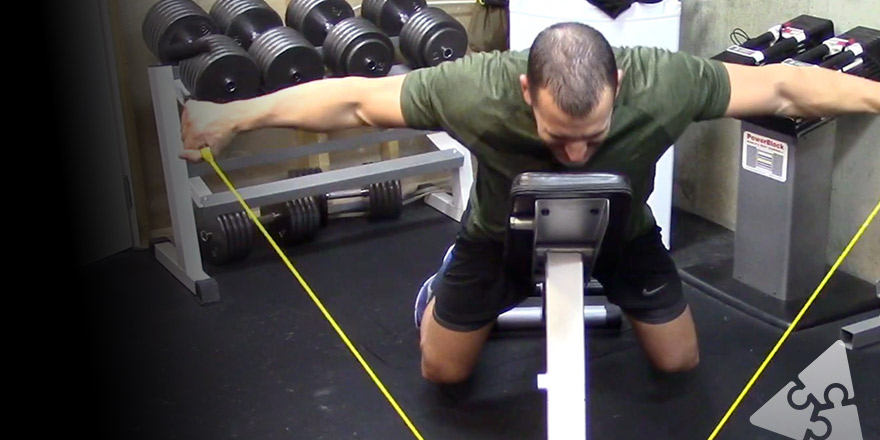This is an advanced resistance bands training strategy to help you reasonably stick to your workout(s) when you’re traveling for work or even on vacation.
Many people write me as though “all is lost” when they have to travel for business or some related reason. But real life happens, and there are strategies you can use to deal with these things.
The difficulty is in sticking to your own program guidelines. For example, let’s say you’re on a workout program that looks like this:
- Monday: Chest
- Tuesday: Shoulders
- Wednesday: Arms
- Thursday: OFF
- friday: Legs
- Saturday: Back
- Sunday: OFF
Next week, you’re going to be travelling Monday to Friday for a conference, and you know, based on the conference schedule, that you know for sure you can’t workout on Wednesday, but you sort of can Tuesday and Thursday, and Monday is sort of up in the air, and…
Normally, this is very difficult to navigate. You may get in one bodypart training day but you can’t guarantee you’ll get in the others in their assigned sequence.
This doesn’t need to throw off your plan if you use a strategy I like to call, “Programmus Interruptus”
🎙
Pssst, hey you! Yeah, you. You can listen to Scott and Mike explain this strategy on the podcast by clicking here.
Before we begin…
The first principle of this strategy is doing what you can, and making the most of what you can do.
For example, I recently had to travel across the country, back and forth, and I wasn’t sure to what extent my time would be by own each day. Meetings could begin as early as 9:30, and I didn’t know how long they’d take.
Since I’m an early riser, I just asked for a 3:30 am wake-up call each morning. From there, I hit Tim Horton’s for a wake-up cup of coffee and then I found a 24 hours gym nearby.
A new or unfamiliar gym, for me, gives me a chance to experiment with different machines, equipment, gym lay outs, or whatever. It took some getting used to, but that’s part of the fun. I easily made it work within the parameters of my workouts.
By the time I’d finished working out and showering, I was ready to go before a normal person’s day ever gets started. I even had time to sit down and clear my email inbox before heading to the days of meetings downtown.
That was one trip where I could make it work each day, just by waking up early. But there are other trips where I’ve had to move a workout around, or skip one here and there because the traveling and meetings themselves would exhaust me.
My point here is that you do what you can, but you should also realize that a slight interruption is not a problem. Moving a workout around here and there is fine.
So with that in mind, let’s move on to the Programmus Interruptus strategy.
Programmus Interruptus
The first thing I recommend in this scenario is to switch to whole body workouts—but in a very specific way.
If you are going to be away for two weeks or less, then this switch makes perfect sense. By working out the whole body when you reasonably can you will give yourself an even stimulus across all the bodyparts. You’ll still be training, but you’ll have more flexibility, all things considered.
Now, keep in mind that you can still largely stick to your regular bodypart workout split because even with “whole body” workouts you can add a bodypart focus. I’ll show you how below.
If time is an issue, you can also break these workouts down into biplexes and triplexes (groups of two and three exercises back-to-back), as in my Hardgainer Solution program. If time is really an issue, you can even do everything one big circuit. This gives you a bit more of a conditioning focus, but for a workout here and there, it’s not a big deal. You do what you can.
This is also something you can pre-plan well in advance of your travels. Below is one scenario I laid out as an example of a bodypart “focus” whole body blast.
Example: “Shoulder Day” with limited time
In this scenario our traveller on business, and his first morning of traveling would normally be “shoulder day.” However, he is scheduled for a whole week of meetings, and he’s not sure how long his work days will be. In other words, he *can* do shoulder day on that first day, but he’s not sure about the rest of the week. Also, he can’t really get to a full gym for the workout. He’s got to squeeze it in from his hotel room or whatever exercise room they have on premises.
So, what does he do?
In this case, we’ll “split the difference.” We’ll do a workout with a clear shoulder emphasis, but we’ll also integrate it with a whole body workout or whole body blast.
We’ll give shoulders a lot of volume, but in between sets for the shoulder exercises we’ll hit every other bodypart with one exercise, and we’ll do it with a “stimulate, don’t annihilate” emphasis (i.e., pumping reps, not hardcore strength work).
By switching to a whole body blast while still getting in the shoulder volume, our traveler still manages to maintain their workout momentum built up to that point. They’re making the best out of the situation—taking life’s lemons and making lemonade, if you will.
The other exercises for the other bodyparts are not the workout focus, but by adding them in, even with less intensity, all the bodyparts get some level of muscle stimulation which should serve to preserve strength and conditioning until the traveler can return to their actual program.
If they can’t workout at all again for a few days, it’s okay. If they can, well then they can get in a similar type workout for their back or legs or whatever bodypart their program calls for.
Shoulder-Focus Whole Body Blast
We pretended that all we had was an adjustable bench and a couple of sets of resistance bands (even though we only used one resistance band).
I’ll let you in on a little secret as to “why” I decided to go with this.
In the hotel I recently stayed at myself they had “an exercise room” – I went and checked it out, out of a sense of curiosity more than anything. This exercise room/fitness room consisted of several treadmills, a couple elliptical machines and a few exercise bikes. Plenty of cardio equipment! But then, packed into a very tight space was an adjustable bench and dumbbells that went up to… 20 lbs. There were also a few resistance bands sitting in a bin, and a functional trainer that may or may not have been actually functional.
This is a common scenario. You can workout in your hotel room, or you can workout in a dedicated exercise room, but there isn’t that much equipment. With that in mind, you can usually plan something out based on an adjustable bench (or a hotel-room couch or chair in a very worst-case scenario) and a set of resistance bands that you can bring with you.
No worries. This image formed the basis of the shoulder-based whole body blast you see here below. I made this workout up on the spot with Byron.
As you can see we cover every single body part, but we get 6 exercises for shoulders in multiple ranges and planes of motion, with some exercises harder in intensity than others. But remember, when traveling with long days, the training tactic is to “stimulate” and that is good enough. Trust me, though, after 3 or 4 rounds of this you won’t feel like your workout program has been “compromised’ and when you go back to your program when your travel is complete, you will be better suited to pick up right where you left off.
Application Notes:
- You don't have to do this in a circuit like I did. In this particular example, I chose to execute this whole body blast as a circuit. This adds a bit more of a metabolic blast to the workout, which is also beneficial if time is in short supply. But again: this doesn’t have to be a circuit by any means. These types of workouts could just as easily be broken down into biplexes or triplexes.
- If you're only using resistance bands as per this example, I suggest keeping the rep ranges at 12-15 for the more challenging exercises – 15-20 reps for exercises that are just meant to ‘stimulate’ the muscle group but to just keep the circuit going.
- The focus on these types of whole body blasts is NOT the load. The important focus is on ‘continuous tension’ on the targeted muscles.
- Notice how Byron doesn’t let go of the bands between exercises. You could just as easily employ several different band strengths as well. But I wanted to present to you a minimum case example.
- Notice that Byron adjusted his grip on a few exercises right in the middle of executing the set. This is fine. Too many trainees are far too mentally rigid and stiff when approaching a workout session that demands some on the spot adaptability. You have to be willing to adjust to make an exercise harder or easier depending on the tension you feel during those first few crucial reps.
- For this example, an even pace is more important than trying to be in an overwhelming oxygen deficit.
- Take a longer rest at the completion of the whole circuit. Then execute the next round.
- I created this circuit minutes before we executed it for the camera. I even changed up a couple of exercises I was planning to put in, right on the spot as Byron was going through it. However, even if you do this for another bodypart or make up your own workout, I recommend jotting down the exercises, the rep ranges, and so on, before you begin, and then sticking to that. This will help with your focus during the workout.
Follow along with the video here:
| Prone Supported Rear Delts Flyes | X’s 15-20 | Delts |
|---|---|---|
| Seated Low to High Rows | X’s 20 | Back |
| Upright Rows | X’s 15-20 | Delts |
| Incline Chest Flyes | X’s 15-20 | Chest |
| Single-Arm Side Laterals (lying on side) | X’s 12-15 | Delts |
| Two-Arm Triceps Kickbacks | X’s 12-15 | Triceps |
| Two-Arm Front Raises | X’s 12-15 | Delts |
| Leaning Angled Biceps Curls | X’s 15-20 | Biceps |
| Kneeling Shoulder Press | X’s 15-20 | Delts |
| Alternating Reverse Lunges | X’s 12-15 EL | Legs |
| Standing Shrugs | X’s 20 | Delts |
You can see how the structure alternates shoulder exercises with exercises for other bodyparts.
We ended up with an 11-exercise circuit, which is more than enough overload for the target muscle of the workout — shoulders — and enough stimulation of other bodyparts for muscle maintenance, just in case it may be a few days before getting back in the gym, or even several more days before getting back to your actual program.
And this is just one type of extreme example. The single bodypart focus whole body blast has an endless spectrum of possibilities to apply to scenarios of “programmus interruptus.”
I hope this particular on the spot creation should give you some ideas of your own when traveling.

